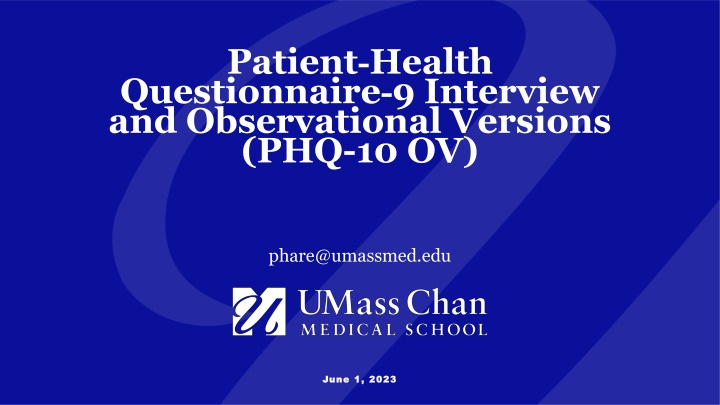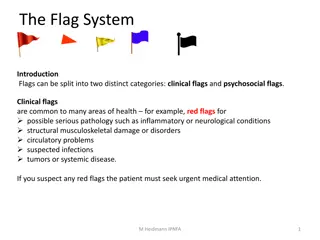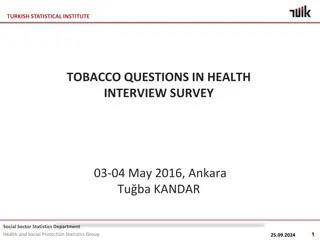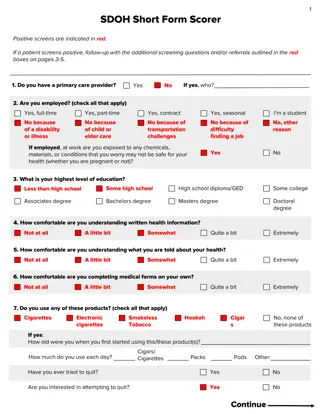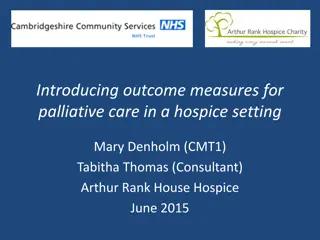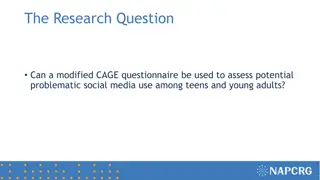Patient Health Questionnaire 9 (PHQ-9) Development Overview
Standard measure of depression, the PHQ-9 includes anhedonia, dysphoria, sleeping, energy, appetite, self-worth, concentration, motor, and suicidality. The PHQ-10.OV is a staff questionnaire based on PHQ-9 observations, used in various populations. Psychometrics validation and symptom severity levels are detailed, with citations supporting its utility and sensitivity to change.
Download Presentation

Please find below an Image/Link to download the presentation.
The content on the website is provided AS IS for your information and personal use only. It may not be sold, licensed, or shared on other websites without obtaining consent from the author.If you encounter any issues during the download, it is possible that the publisher has removed the file from their server.
You are allowed to download the files provided on this website for personal or commercial use, subject to the condition that they are used lawfully. All files are the property of their respective owners.
The content on the website is provided AS IS for your information and personal use only. It may not be sold, licensed, or shared on other websites without obtaining consent from the author.
E N D
Presentation Transcript
PatientHealth Questionnaire 9 Interview and Observational Versions (PHQ-10 OV) phare@umassmed.edu June 1, 2023 June 1, 2023
Table of Contents Table of Contents Background on Scale Development MDS Items Distribution of Missingness Distribution of the Scale By Year By Reason for Assessment Technical Notes SAS Code 2
Background on Scale Development Patient Health Questionnaire 9 (PHQ 9): A standard measure of depression in the MDS 3.0, including anhedonia, dysphoria, sleeping, energy, appetite, self- worth, concentration, motor, and suicidality Structured and validated depression interview tested in older adults, home health, persons with cancer, persons with spinal cord injury, rehabilitation populations; wide use in community and hospital settings and has been shown to be sensitive to change over time. 9 items, range from 0 to 27. A higher score indicates a greater depressive symptoms. Patient Health Questionnaire Observational Version (PHQ-10 OV): A staff questionnaire with the intent of having the PHQ-9 collected from staff reports of their observations for residents who could not self-report. PHQ-10 OV includes the nine signs and symptoms of depression found in the PHQ-9 plus an additional irritability item. 10 items, range: 0-30. A higher score indicates greater depressive symptoms. Citations regarding psychometrics of the scale: Spitzer RL, Kroenke K, Williams JB. Validation and utility of a self-report version of PRIME-MD: the PHQ primary care study. Primary Care Evaluation of Mental Disorders. Patient Health Questionnaire. JAMA. 1999 Nov 10;282(18):1737-44. doi: 10.1001/jama.282.18.1737. PMID: 10568646. Saliba D, DiFilippo S, Edelen MO, Kroenke K, Buchanan J, Streim J. Testing the PHQ-9 interview and observational versions (PHQ-9 OV) for MDS 3.0. J Am Med Dir Assoc. 2012 Sep;13(7):618-25. doi: 10.1016/j.jamda.2012.06.003. Epub 2012 Jul 15. PMID: 22796361. B langer, E., Thomas, K. S., Jones, R. N., Epstein Lubow, G., & Mor, V. (2019). Measurement validity of the Patient Health Questionnaire 9 in US nursing home residents. International Journal of Geriatric Psychiatry, 34(5), 700 708. https://doi.org/10.1002/gps.5074 3
Background on Scale Development Depressive symptoms: Major depression: total symptoms >=5; Minor depression: 2<=total symptoms<=4 None: else. Level of depression severity: None (0-4) Mild (5-9) Moderate (10-14) Moderately severe (15-19) Severe (20+) Citations regarding psychometrics of the scale Spitzer RL, Kroenke K, Williams JB. Validation and utility of a self-report version of PRIME-MD: the PHQ primary care study. Primary Care Evaluation of Mental Disorders. Patient Health Questionnaire. JAMA. 1999 Nov 10;282(18):1737-44. doi: 10.1001/jama.282.18.1737. PMID: 10568646. Saliba D, DiFilippo S, Edelen MO, Kroenke K, Buchanan J, Streim J. Testing the PHQ-9 interview and observational versions (PHQ-9 OV) for MDS 3.0. J Am Med Dir Assoc. 2012 Sep;13(7):618-25. doi: 10.1016/j.jamda.2012.06.003. Epub 2012 Jul 15. PMID: 22796361. 4
Background on Scale Development Summary of Analyses of psychometric properties Pilot Testing and Item Development in the Veterans Health Administration (Saliba, 2012) Compared with the MDS 2.0 observational items, the PHQ-9 interview had greater agreement with criterion standard diagnostic assessments (weighted k = 0.69, 95% CI = 0.61-0.76). For residents who could not complete the interview, the PHQ-9 OV also had greater agreement with a criterion measure for depression than did the MDS 2.0 observational items. In residents with severe cognitive impairment, PHQ correlations with the criterion standard Cornell Scale were superior to the MDS 2.0 for both the PHQ-9 (0.63 vs 0.34) and the PHQ-9 OV (0.84 vs 0.28). The majority of NH residents were able to complete the PHQ-9, and most surveyed staff reported improved assessments with the PHQ-9 OV. Citations regarding psychometrics of the scale: Spitzer RL, Kroenke K, Williams JB. Validation and utility of a self-report version of PRIME-MD: the PHQ primary care study. Primary Care Evaluation of Mental Disorders. Patient Health Questionnaire. JAMA. 1999 Nov 10;282(18):1737-44. doi: 10.1001/jama.282.18.1737. PMID: 10568646. Saliba D, DiFilippo S, Edelen MO, Kroenke K, Buchanan J, Streim J. Testing the PHQ-9 interview and observational versions (PHQ-9 OV) for MDS 3.0. J Am Med Dir Assoc. 2012 Sep;13(7):618-25. doi: 10.1016/j.jamda.2012.06.003. Epub 2012 Jul 15. PMID: 22796361. 5
Background on Scale Development Summary of Analyses of psychometric properties Validity in US nursing homes (B langer et al., 2018) Internal consistency and structural validity: Confirmatory factor analysis for one-factor and two-factor solutions Overall moderately high standardized factor loadings Good internal reliability with omega values: 0.87>0.85. Fit statistics indicate a good model fit for the PHQ 9: Root mean square error of approximation (RMSEA): 0.04 < 0.05 Comparative fit index (CFI): 0.97> 0.95 Tucker Lewis Index (TLI): 0.96> 0.95 Fit statistics indicate acceptable model fit for the PHQ 10OV: Root mean square error of approximation (RMSEA): 0.06 (not 0.05) Comparative fit index (CFI): 0.97> 0.95 Tucker Lewis Index (TLI): 0.96> 0.95 Slightly poorer model fit and a lower standardized factor loading on the additional irritability item, and it did not yield expected gender differences. Citations regarding psychometrics of the scale: Spitzer RL, Kroenke K, Williams JB. Validation and utility of a self-report version of PRIME-MD: the PHQ primary care study. Primary Care Evaluation of Mental Disorders. Patient Health Questionnaire. JAMA. 1999 Nov 10;282(18):1737-44. doi: 10.1001/jama.282.18.1737. PMID: 10568646. Saliba D, DiFilippo S, Edelen MO, Kroenke K, Buchanan J, Streim J. Testing the PHQ-9 interview and observational versions (PHQ-9 OV) for MDS 3.0. J Am Med Dir Assoc. 2012 Sep;13(7):618-25. doi: 10.1016/j.jamda.2012.06.003. Epub 2012 Jul 15. PMID: 22796361. 6
Background on Scale Development Summary of Analyses of psychometric properties Validity in US nursing homes (B langer et al., 2018) Criterion validity: highly specific but poor sensitivity compared with an administrative reference standard, suggesting that many of those with a diagnosis of depression in claims data are not symptomatic on the PHQ 9. Overall good internal reliability in both newly admitted and long-stay nursing home residents. a valid and promising measurement instrument for research about depression among NH residents; should be examined further against a structured psychiatric interview. Citations regarding psychometrics of the scale: Spitzer RL, Kroenke K, Williams JB. Validation and utility of a self-report version of PRIME-MD: the PHQ primary care study. Primary Care Evaluation of Mental Disorders. Patient Health Questionnaire. JAMA. 1999 Nov 10;282(18):1737-44. doi: 10.1001/jama.282.18.1737. PMID: 10568646. Saliba D, DiFilippo S, Edelen MO, Kroenke K, Buchanan J, Streim J. Testing the PHQ-9 interview and observational versions (PHQ-9 OV) for MDS 3.0. J Am Med Dir Assoc. 2012 Sep;13(7):618-25. doi: 10.1016/j.jamda.2012.06.003. Epub 2012 Jul 15. PMID: 22796361. 7
Background on Scale Development Should Resident Mood Interview be conducted? (D0100_Cndct_Mood_Cd) No Yes Resident Mood interview (PHQ-9) Staff Assessment of Resident Mood (PHQ-10-OV) Total Severity Score (D0600_Stf_Mood_Scre_Num) Depressive symptoms (D0500A-D0500J) Depressive symptoms (D0200A-D0200I) Total Severity Score (D0300_Mood_Scre_Num) 8
MDS Items MDS 3.0 items (PHQ-9) MDS 3.0 items (PHQ-10-OV) Notes: D0100_Cndct_Mood_Cd = 1 D0100_Cndct_Mood_Cd = 0 D0100_Cndct_Mood_Cd Should Resident Mood Interview be conducted? 0. No-> Skip to and complete D0500-D0600, staff Assessment of Resident Mood (PHQ-10-OV) 1.Yes -> Continue to D0200, Resident Mood interview(PHQ-9) Anhedonia: D0500A1_Stf_Intrst_Loss_Cd; D0500A2_Stf_Intrst_Loss_Freq_Cd Anhedonia: D0200A1_Intrst_Loss_Cd; D0200A2_Intrst_Loss_Freq_Cd Dysphoria: D0500B1_Stf_Feel_Down_Cd; D0500B2_Stf_Feel_Down_Freq_Cd Dysphoria: D0200B2_Feel_Down_Freq_Cd ; D0200B2_Feel_Down_Freq_Cd Sleeping: D0200C1_Trbl_Sleep_Cd; D0200C2_Trbl_Sleep_Freq_Cd Sleeping: D0500C1_Stf_Trbl_Sleep_Cd; D0500C2_Stf_Trbl_Sleep_Freq_Cd Energy: D0200D1_Ltl_Enrgy_Cd; D0200D2_Ltl_Enrgy_Freq_Cd Energy: D0500D1_Stf_Ltl_Enrgy_Cd; D0500D2_Stf_Ltl_Enrgy_Freq_Cd Appetite:D0200E1_Poor_Aptit_Cd; D0200E2_Poor_Aptit_Freq_Cd Appetite: D0500E1_Stf_Poor_Aptit_Cd; D0500E2_Stf_Poor_Aptit_Freq_Cd; Self worth: D0200F1_Self_Dprctn_Cd; D0200F2_Self_Dprctn_Freq_Cd Self worth: D0500F1_Stf_Self_Dprctn_Cd; D0500F2_Stf_Self_Dprctn_Freq_Cd Concentration: D0200G1_Cncntrtn_Cd; D0200G2_Cncntrtn_Freq_Cd Concentration: D0500G1_Stf_Cncntrtn_Cd; D0500G2_Stf_Cncntrtn_Freq_Cd; Motor: D0200H1_Mvmt_Dfrnt_Cd; D0200H2_Mvmt_Dfrnt_Freq_Cd Suicidality: D0200I1_Ngtv_State_Cd; D0200I2_Ngtv_State_Freq_Cd Motor: D0500H1_Stf_Mvmt_Dfrnt_Cd; D0500H2_Stf_Mvmt_Dfrnt_Freq_Cd; Total Severity Score: D0300_Mood_Scre_Num Suicidality: D0500I1_Stf_Ngtv_State_Cd; D0500I2_Stf_Ngtv_State_Freq_Cd; Irritability: D0500J1_Stf_Shrt_Tmpr_Cd; D0500J2_Stf_Shrt_Tmpr_Freq_Cd; 9 Total Severity Score: D0600_Stf_Mood_Scre_Num
Technical Notes Different wording of PHQ-10OV for low self worth and suicidal thoughts which refer to behavioral manifestations: indicating that s/he feels bad about self, is a failure, or has let self or family down, and states that life isn't worth living, wishes for death, or attempts to self harm. 10
